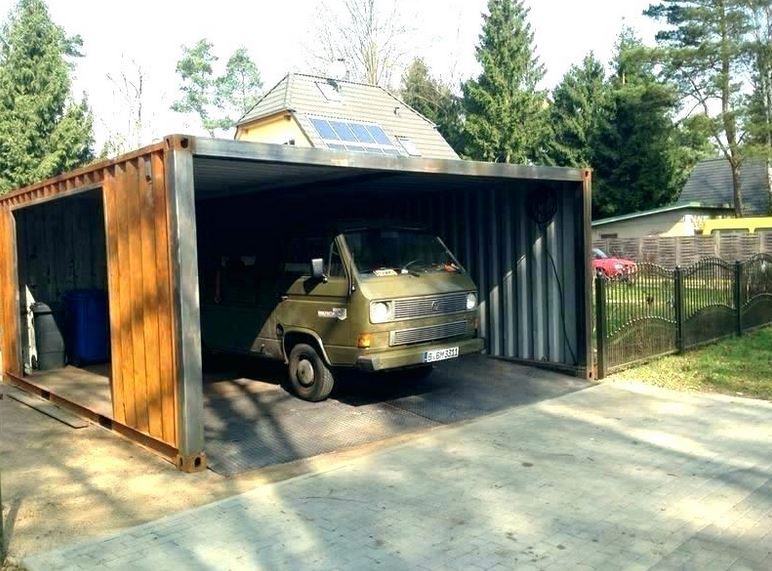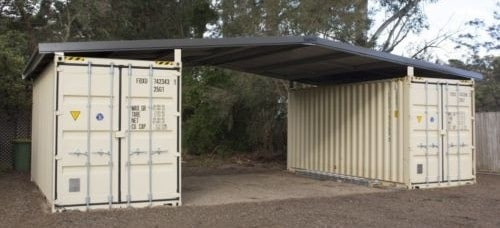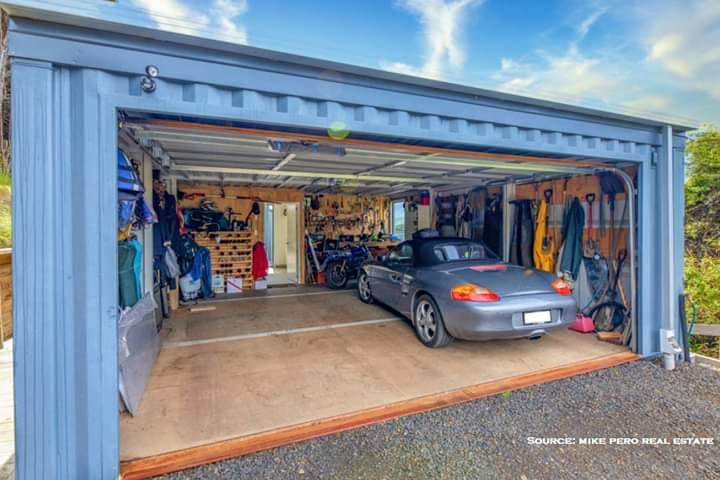Shipping Containers For Sale
Shipping Container Garage
Shipping Container Garages
Can you use a shipping container as a garage?
The simple answer is yes! It’s definitely possible to use a shipping container as a garage. Let’s explore some of the common questions and tips for using a shipping container as a garage..

Image source: https://nairobiwire.com
If you have been following the Conex Depot Blog articles, you will have seen that there are a wide variety of uses for used shipping containers. Many Americans have repurposed the empty steel containers to store their household and business goods, including vehicles.
In this week’s blog post, we look at using a used shipping container as a garage. We answer some of the common questions, provide some helpful technical information and provide some tips to help you decide if building a shipping container garage is the solution to storing your car or truck.
Homeowners that live in a house that does not have an existing garage can always build an addition – depending on local zoning laws. Or alternatively, they can look to an unorthodox solution in a shipping container garage.
Without a garage, owners are left to park their cars on the street. This may affect insurance rates and exposes the vehicle to vehicle break-ins or, worse, car theft. Searching Google for a solution will show that some more creative thinkers use a shipping container as a garage.
Business owners and private companies who have run out of garage space and require convenient and secure storage for their vehicles also have employed used Conex containers as garage storage.
What are the advantages of using a shipping container garage?
In the most basic type of use as a garage, a steel container provides a secure, lockable metal box for any vehicle – from classic cars to lawn and garden machinery. And we will see later several containers that can be modified and assembled to create a custom-designed shipping container garage for your home or business.

Image source: Green Tractor Talk
Convenience and speed. Any private homeowner with adequate space on their property can easily place a shipping container on the land. In most areas of the USA, you do not need planning permission or permits for temporary storage. If you have doubts, you should contact your Municipal Planning Authority with any questions that you have. A used shipping container purchased online can be delivered directly to your property within days.
Security and protection. A steel cargo container offers solid security and long-term durability in a dry environment. Steel shipping containers are rated as WWT (Wind and Water Tight) – which protects your stored vehicles from the extremes of weather.
For many owners, security is the primary selling point of a container garage, as they are constructed of heavy gauge Corten steel and are burglary resistant to the majority of break-in attempts by criminals if outfitted with a quality lock. The construction of the shipping container doors is designed so that it is extremely difficult for a potential thief not be able to use the common tools to break the lock and gain entry to your shipping container.
One collector of motorcycles loves his shipping container garage for the convenience of storage on his property and the confidence that he has in the security of his bikes. A 20-foot shipping container has adequate space to store multiple motorcycles (or other types of smaller vehicles or lawn maintenance equipment) easily inside – and they are protected against thieves.
A few factors to think about
There are a number of factors to consider if you are thinking about whether to buy a shipping container to use as a garage.
First, you are going to need enough space on your property to place the container, with adequate room to be able to wheel vehicles in and out of the container. The most common sizes of Conex boxes are 20 ft and 40 ft in length and a width of approximately 8 feet.
A solid foundation. A heavy steel shipping container requires a level and solid surface to be placed. Most shipping container owners will prepare a simple foundation of blocks, a concrete slab, or railroad ties to place the container on. This step ensures that the container will not shift from the weight of the contents inside and makes it easier to move the container in the future. It’s not advised to place your container on land that is poorly drained, as rainwater accumulation in the soil may cause the container to shift and warp.
In areas of the USA that have extremes of cold and heat and high humidity, you may need to install basic ventilation on the shipping container so that condensation doesn’t create humidity problems for vehicle engines.
Size limitations. It seems obvious, but you need to select a container that has the correct door opening width to fit your vehicle inside. Does a shipping container have enough space to store the average car or SUV inside? Let’s take a look at some simple numbers.
How wide is a standard 20-foot shipping container?
The standard width is 8′ feet.
The specific dimensions of a 20-ft container are:
Exterior Dimensions (in feet): 20′ long x 8′ wide x 8′ 6” high. In meters: 6.10m long x 2.44m wide x 2.59m high.
What is the widest-sized shipping container you can buy?
Extra-wide shipping containers are cargo containers with additional width to fit larger single-piece items. Compared to a standard shipping container which has an external width of 8′, the extra-wide Conex containers feature an external width of 10′. Depending on the special cases of your vehicle storage requirements, these precious two extra feet can give you the additional room that you need. Note that extra-width containers are not as commonly available and may require some extra effort to locate in your area.
Will the average vehicle fit in a shipping container?
The average car in the USA is 5.8 feet wide and will easily fit inside a shipping container. This also allows for the additional space required to open the car doors.
Vehicle widths vary according to vehicle type, make, and model, of course, but as long as you have a standard make, you will be fine.
How wide is the average SUV?
Will your larger SUV fit inside a shipping container?
The average specs for the full-size SUV category: Height: 75.4 inches. Weight: 5,706 lbs. Width: 80.2 inches.
The height of an SUV isn’t a problem. A compact SUV will measure between 5 to 5.5 ft (61 to 66 inches) high, a mid-size SUV will fall somewhere closer to 5.6 ft (68 inches), while a full-size SUV is the tallest, ranging between 6.1 to 6.3 ft (74 to 76 inches) on average. The height of the standard shipping container is a roomy 8.5ft (2.59m) high.
The width can be a problem for the largest-sized SUVs. If you have one of the full-sized SUVs – you had better measure it before making plans to store the SUV in a shipping container garage!
But I need a bigger shipping container garage!
If your shipping container garage requires more space, the best practical solution is to have one or more sides cut out from the container and put two containers together.to provide double the space. This will require the expertise and equipment of a welder, but at least you know that you have options if you need much more storage space in your cargo container garage.
Check out this double garage constructed out of 3 shipping containers

Image source: Shipping Container Home UK Facebook https://www.facebook.com/shippingcontainerhomesuk
Shipping container garage renovations
While we are covering the topic of altering your shipping container to use it as a garage, there are a few common ways that we have seen container owners customize their empty boxes to serve as a garage.
Read more:Best Shipping Container Refurbishing Ideas
A side door may be cut into the container to provide easier access. With a conveniently placed door, the problem of opening the car door inside the container is solved. You may easily open the car door and exit out of the side door without trying to squeeze yourself out of the restricted space in the container.
Those using their shipping container garage primarily for storage also add shelving, workbenches, and other common workshop amenities. This makes it more like a traditional garage space that provides space to work on your DIY projects and vehicle maintenance.
There are different styles of doors that you can customize your container with. The traditional rolling shutter is perhaps the most popular and convenient to use. Any structural alterations of the container may compromise the security of your container. It’s recommended that you seek professional advice when making a significant alteration to the container doors and walls.
As you will be rolling in heavy vehicles, a ramp of some sort is essential. This simple addition will help make access much smoother.
Many shipping container owners install some basic form of insulation to protect against damage from moisture and condensation buildup when the steel containers heat up in the summer, and the temperature drops radically in the winter. Insulation helps protect against moisture accumulation inside the container and reduces the risk of moisture problems on your stored vehicles.
Read more on how to insulate a shipping container https://www.conexdepot.com/how-to-insulate-a-shipping-container/
Shipping container garage customizations
Painting your container – Painting your shipping container garage not only helps protect the surface against the damage caused by rust getting a foothold, but it also dramatically improves the aesthetic appearance. You will look to use high-grade paint suited for painting on metal surfaces. The limit is your imagination when it comes to pimpin’ your container!
Ventilation – Shipping containers come equipped with basic vents in the walls to deal with temperature fluctuations that occur during their long sea voyages. If your specific climate (think Florida and Texas!) has extremes of heat and cold, and humidity, you will want to look into installing adequate ventilation.
Wall Shelving – Most garages feature shelving to organize all of your tools and maintenance stuff. Most big box home stores carry kits for interior shelving that are easy to put up and customize for your space.
Locks and security – Many people who buy a shipping container for storage install an extra lockbox on the doors of the container. This simple addition makes it very difficult for a potential burglar to use the most common tools that are used to break the padlocks on doors. It’s a simple modification, but the peace of mind of knowing that your vehicles and possessions are secure is invaluable.
Electric hookup – If you intend on using your shipping container garage as a workspace, you will certainly need to have an electrical supply installed. At the very minimum, a source of overhead light is essential. And in colder climates, a heater is a must if you intend on spending any time inside the container.
In a nutshell: Pros and cons of a shipping container garage
Pros:
A shipping container garage can be put together from nothing in only a few days. You buy your used shipping container online, have it delivered, and you are ready to start using your garage.
If you buy a shipping container online, you can get a great deal – cheaper than building a garage from scratch. And no municipal building permit is required.
Secure and safe from thieves. Durability is a major plus. Steel containers are made to protect cargo during long sea voyages. They are built to withstand the extremes of weather and keep the contents safe and dry.
Can be moved at a later date in time if your life circumstances change and you need to relocate.
Shipping containers are generally easy to customize. From insulating the walls and outfitting it for a custom garage with shelving and work tables to converting it into a shipping container garage by combining multiple containers together.
Cons:
You have the width limitations of the standard-sized shipping containers – 8 feet is the standard width. Might be a no-go as far as parking your extra-wide Humvee inside
The metal walls are not well insulated, and internal temperatures can really swing during the seasons.
The container is large, heavy, and unwieldy. You will need the help of a truck to load and transport your container to your location.
Is a shipping container garage the ideal solution for your home and business vehicle storage needs?



 Quick Quote
Quick Quote